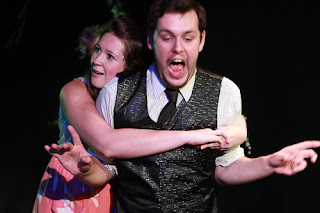Day 83
22nd August 2012
This evening I was asked by Tread The Boards theatre company to photograph their final dress rehearsal, and use some of the images outside of the entrance to let the audience know what they are in for!
I have done this 'job' before, and I always find that it's trial and error to get your good shots. Always juggling ISO, shutter speed and aperture, it's difficult to get right. Especially in the dark of the audience!
Here comes the science. Skip to the pictures if you don't like lectures! Maybe you might learn something!
ISO
The sensor's sensitivity to light, normally runs from 100, 200, 400, 800, 1600, 3200. At 100, the sensor is very sensitive to light, and is perfect for shooting in sunlight/outdoors. At 3200, the sesnsor doesn't really care anymore, it just wants to brighten things up at any cost, so for that reason you lose quality. The darker the scene/lighting, be it natural or illuminous the higher you have to mark your ISO - that is of course providing you don't want to use flash.
Aperture
This is the part of the lens that you pay your money for! Anywhere from wide as f/32 to f/1.2, you can actively tell the lens how much light to let in. This is controlled by the motors inside the lens that open up to the width of your lens, or decrease to the size of a pea - and smaller. A wide aperture, f11 and above, is ideal for landscapes, as then you can really get everything into focus, as well as absorbing those nice colours in the sky. This would be no good indoors though, as there is a mild chance that everything will be dark at that level, which is where you use your low numbers. Also low f stop numbers help you to isolate your subject and get a really sharp focus on one thing.
Shutter Speed
Basically, the blink of an eye. Imagine opening and closing your eye anywhere from 1/4000'th of a second - all the way to 30 seconds, thats how ss basically works. It's the amount of time that the mirror in the camera has to deflect what it sees through the lens, up to the sensor. Faster shutter speeds are great for sport, capturing a surfer on wave for example, freezing the action in time, getting those droplets of water flying around. Long shutter speeds are perfect for night photography, capturing a busy city scene - like London Bridge lit up at night - it doesn't change colour or move (except when the Queen sails through), so you can shoot a long exposure, also water is great for this, as it smooths out the surface.
Flash
Everybody uses flash on cameras, but when is it most effective? Obviously as a substitute for natural or low light. It makes camera believe that there is more light around what you are shooting than there actually is. With DSLR's, Flashguns are a musthave for indoor photography (i actually haven't got one), as the inbuilt flash that pops up isn't great - it's harsh, and always washes out people's faces of any natural skin tone. External flash however, is great because you can change the direction of the flash, bouncing it off hard surfaces that maybe around the subject. Flash can really save the day! I doubt you'd ever see a wedding photographer shooting indoors wihout their flash.
The human eye has all these things in built (apart from flash), I'll give you some for instance's.
When you've been in a really bright outdoorsy type of place, and you have to go in to a room with no windows or the curtains drawn with no light, or vice versa, when your eyes adjust themselves to the available light - this like ISO, sensitivity to light. Or when you wake up, with a rotten hangover. Like that.
When you focus on your finger in front of your nose (closing one eye), your pupil dilates slightly to let more or less light in, and when you move it away further or take it away, your pupils adjust automatically. This like aperture, constantly evaluating what we look at, and what we focus on. We can't focus on everything all the time, no matter how 20/20 you are!
When you close your eyes, and open them for any length of time, that's shutter speed. Imagine that a camera's eye is always closed, and only opens when you take a shot.
That being said, you can tell how many things there are to consider when shooting indoors, without a flash, it's a constsnt balancing act, with change of lighting in theatre, the moving people and their props - here are a few shots of the show.
So if the pictures are blurred, not light enough, too dark, if the quality isn't quite right - you know how to fix it! Get your camera out and go take some pictures!
Tread The Boards 22/8/12
A Midsummer Night's Dream























No comments:
Post a Comment